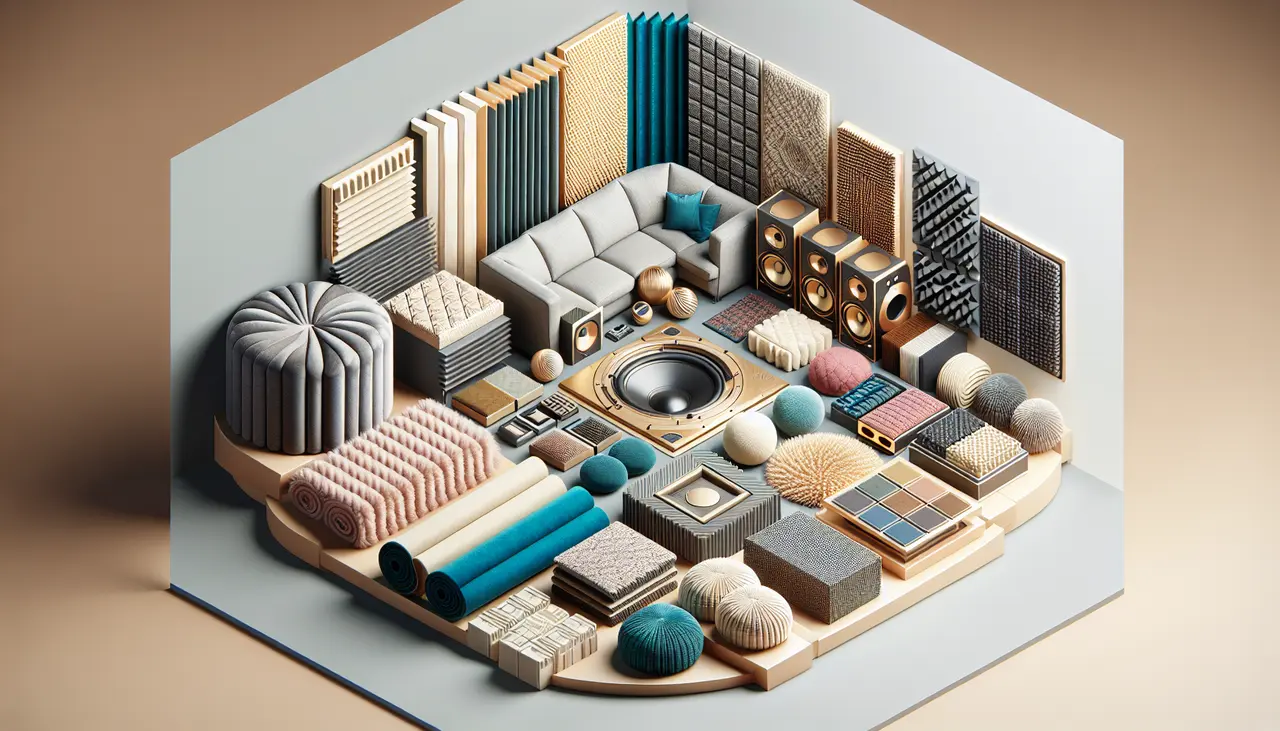
Introduction to Home Theater Acoustics
Getting the sound right in your home theater is just as important as a crisp, clear picture. Ever noticed how some rooms make music sound better, while others make it feel like you’re listening through a tin can? That’s all about acoustics. Acoustics is how sound moves and behaves in a space. When setting up a home theater, think of your room as a blank canvas. Your goal? To shape the sound in a way that makes your movie or music experience immersive, almost like you’re part of the scene or in the studio with the musicians. It’s not just about the tech and gadgets you use; the materials in your room play a massive role in this. The wrong materials can bounce sound all over the place, creating echoes, while the right ones can absorb excess noise, making the sound crisp and clear. Whether you’re a die-hard movie fan or a music enthusiast, understanding the basics of home theater acoustics is the first step in transforming your space into a personal entertainment haven.
Understanding the Role of Materials in Acoustic Enhancement
Materials are paramount when it comes to acoustics in a home theater. Think about it - sound travels, and the materials in the room either absorb, reflect, or diffuse it. To get that crisp, clear sound, you need materials that work in your favor. Let’s break it down simply. Thick, soft materials like carpets and heavy curtains absorb sound. This means less echo and background noise, giving you cleaner audio quality. On the flip side, hard surfaces like wood or concrete reflect sound, which can lead to echoes and muffle the audio clarity. Then, there are materials that can diffuse sound - these scatter the sound waves, reducing spots where the sound is too loud or too soft. Strategic placement of these materials throughout your home theater can vastly improve your listening experience, making sure you catch every whisper, every footstep, and every explosion in full, immersive detail. So, when planning your home theater, think beyond just aesthetics. Choose materials that enhance the acoustics and ultimately, your movie-watching experience.
Choosing the Right Carpet Material for Optimal Sound Quality
When setting up a home theater, the type of carpet you choose has a big impact on sound quality. It might seem minor, but it’s a game changer. For the best sound, you want a carpet that absorbs noise, not bounce it around. Thick, dense carpets are your best bet. Think plush or high-pile carpets. These types soak up sound waves, reducing echo and making dialogue in movies clearer. Berber carpets? Not great. They’re too thin and they’ll let sound waves bounce, making your audio muddy. Color or style doesn’t affect sound, so go wild with those. But for material, stick with something thick. It’s an easy choice that makes a big difference.
The Importance of Curtain Material in Home Theater Acoustics
Curtain material plays a big role in how good your home theater sounds. It’s not just about blocking light; it’s about sound quality too. Thick, heavy fabrics like velvet or wool do a great job of absorbing sound. This means they can help stop echoes and make dialogue clearer. If you’ve got a lot of hard surfaces in your room, like wood floors or concrete walls, these materials can make a big difference. Light fabrics like linen, on the other hand, won’t do much for your sound. They might look nice, but they’ll let sound bounce right off. So, when picking curtains for your home theater, think heavy and thick. Your ears will thank you.
Balancing Aesthetics and Acoustic Performance in Your Home Theater
When setting up your home theater, finding the perfect balance between looks and sound quality is key. It’s easy to get caught up in picking out materials that look good but don’t forget that every choice impacts the sound. Thick, plush carpets can absorb sound, reducing echo, making dialogue clearer. Meanwhile, heavy curtains can prevent sound from bouncing off windows and muddling what you hear. The trick is choosing materials that do both: please the eye and enhance sound.
Consider the color and texture of your carpets and curtains, making sure they fit your home theater’s visual theme. But, also think about their thickness and material composition. Denser fabrics and materials usually offer better sound absorption. So, while it might be tempting to go for that sleek, modern look with hard surfaces and minimalistic design, remember that soft furnishings are your friends in a home theater.
In short, don’t sacrifice aesthetics for acoustics or vice versa. You can have a good-looking home theater that sounds great too. It’s about striking a balance, using thick carpets and heavy curtains that match your visual style while improving the sound quality of your movies and music.
Tips for Selecting Wall Fabrics and Coverings for Better Sound
When it comes to home theater setup, your walls play a crucial role in sound quality. The right wall fabrics and coverings can absorb unwanted echoes, making dialogues crisp and sound effects more impactful. Let’s keep it simple; you want your movie experience to be immersive, and the materials you choose for your walls can help achieve that.
First, consider thick, soft materials. Fabrics like velvet or thick wool are great for absorbing sound. They reduce the bounce-back of sound waves, ensuring clearer audio. Next, let’s talk about placement. Focus on covering the walls directly adjacent to your speakers first. These areas are critical in preventing sound reflection.
For those looking for an easy fix, ready-made acoustic panels are your friends. They’re specifically designed to enhance sound quality and are simple to install. Plus, they come in various styles to match your decor.
Remember, the goal is to balance sound absorption without making the room too “dead.” A mix of covered and bare walls can help achieve the right acoustics. By choosing the right materials and strategically placing them, you’ll create a home theater that rivals the best cinemas.
How to Combine Different Materials for the Best Acoustic Results
Combining different materials to enhance your home theater’s sound is not rocket science. It’s about playing with soft and hard surfaces to control how sound waves bounce around. Soft materials like carpets, thick curtains, and upholstered furniture absorb sound, reducing echoes and making dialogue clearer. Hard surfaces, such as bare walls and floors, can reflect sound, creating a mix that leads to a lively but controlled sound environment.
Here’s a straightforward approach: Start with a thick, plush carpet. It’ll absorb a lot of the echoes right off the bat. If you can, go wall-to-wall. Next, think about your walls. A mix of bookshelves filled with books (not too tightly packed), acoustic panels, and some areas left bare can work wonders. For your windows, heavy curtains are your best friend—they’ll help keep unwanted noise out and improve the sound inside.
Your ceiling shouldn’t be forgotten. If possible, add some acoustic tiles or even a soft, textured ceiling paint. When it comes to your furniture, go for pieces that are plush and have fabric. They’ll help absorb sound. Finally, experiment with positioning. Sometimes moving a couch a few feet can dramatically improve your audio experience.
In summary, the key is balance. Combine hard and soft materials to manage sound reflection and absorption. This balance will help you achieve the best acoustic results in your home theater. Keep it simple, and don’t be afraid to experiment with what works for your space.
The Impact of Furniture Upholstery on Home Theater Sound
Furniture upholstery affects more than just the comfort of your seating; it plays a crucial role in your home theater’s sound quality. Soft, thick materials like velvet or microfiber absorb sound, which can minimize echoes and make dialogue clearer. On the flip side, leather might look sleek and be easy to clean, but it reflects sound, potentially muddying audio clarity. So, when you’re picking out that perfect couch or recliner for movie nights, remember the material matters. It’s not just about sinking into comfort as you watch your favorite film—it’s about ensuring every word and sound effect hits your ears just right. Think of it as tuning your audio experience with fabric choice.
Professional Advice: Consulting with Acoustic Experts
When it comes to turning a room into a home theater, every detail counts, including the acoustics. If you’re serious about getting the best sound quality, talking to an acoustic expert is a smart move. These pros know exactly what materials work best in different spaces to enhance sound. They’ll tell you where to place your speakers, which direction they should face, and what kind of carpets or curtains will help reduce echo, making dialogue clearer and explosions in movies feel more real. The advice might seem simple, but it’s backed by science and years of experience. Sure, consulting with an expert adds to your budget, but think of it as an investment. Better sound equals a better movie-watching experience. Trust me, once you hear the difference, you’ll know it was worth every penny.
Conclusion: Creating the Perfect Acoustic Environment in Your Home Theater
Crafting the perfect acoustic environment in your home theater isn’t just about having the latest gadgets; it’s equally about selecting the right materials. From the carpet on your floor to the curtains on your windows, each element plays a vital role in absorbing unwanted sound echoes and ensuring that rich, crisp sound quality we all crave. Here’s the deal: stick to thick, plush carpets and heavy, dense curtains. They’re your best friends in minimizing echoes. Remember, in the world of home theater acoustics, thicker and denser materials lead to better sound. It might sound simple, but making these careful choices can transform your movie-watching experience from average to extraordinary. So, before you splurge on that top-of-the-line speaker system, take a moment to look around your room. Sometimes, the key to unlocking incredible sound lies not in the electronics, but in the very fabrics and materials that surround you.


